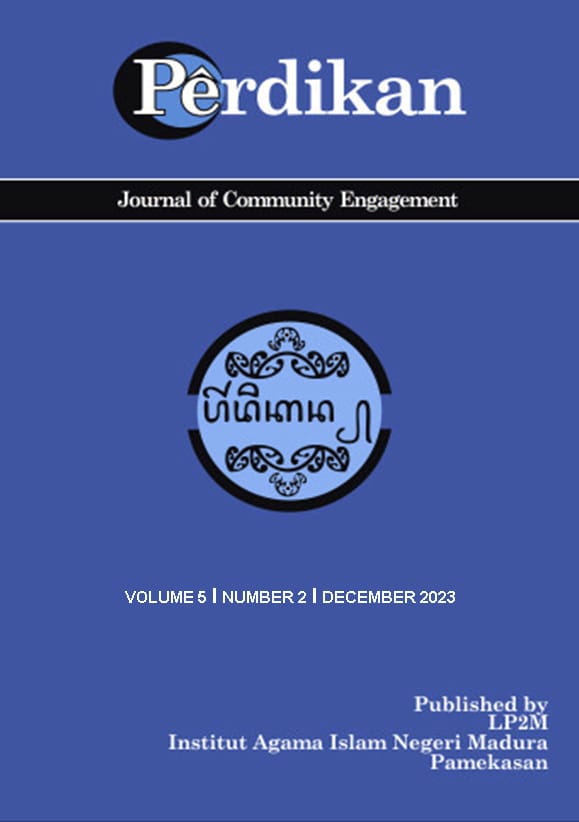Improving high school students’ basic skills to analyze nutrition value labels of food products
 Abstract views: 283
,
Abstract views: 283
,
 PDF downloads: 238
PDF downloads: 238
Abstract
The nutrition label is important for commercial food products to be available in the market and is compulsory to be included in the package. This paper's objective is to present the training description and its effectiveness in improving students' knowledge regarding creating nutrition labels for food products based on BPOM regulation. An experimental with Community Based Research approach was used in this study. A total of 26 female students from Senior High School (SHS) 1 Karas were involved in a one-day training. Based on the observation, most students were fairly participated during the training (33.4%). There was a significant increase in the respondents' knowledge after vs. before the training (45.77 vs. 32.69, p-value<0.05). We found a trend that students who performed low participation tended to have a lower post-test score. The student's participation during the training seems to correlate positively with the post-test score. We confirmed this relationship with Spearman rho's test, in which the correlation was 0.85 (p-value<0.05), suggesting that the correlation was strong enough. Our study demonstrated that one training session had a significant impact on the first-grade SHS students' knowledge of analyzing the nutrition value label on the food product. Engaging students to participate in the class actively can enhance the student's understanding. More intensive training with innovative methods that facilitate shy students.
Downloads
References
Arafah, K., Amin, B. D., Sari, S. S., & Hakim, A. (2021). The Development of Higher Order-Thinking Skills (HOTS) Instrument Assessment in Physics Study. Journal of Physics: Conference Series, 1899(1), 1–7. https://doi.org/10.1088/1742-6596/1899/1/012140
BPOM. (2019). Peraturan BPOM Nomor 22 Tahun 2019 tentang ING.
Dahiya, S., & Jha, A. (2011). Review of Training Evaluation. International Journal of Computer Science and Communication, 2(1), 11–16.
Fitriyanti, Z., Hariri, H., Rini, R., & Sowiyah, S. (2021). Analysis of Vocational Education Curriculum in ASEAN Economic Community: A Literature Review. Journal of Social, Humanity, and Education, 1(3), 157–170. https://doi.org/10.35912/jshe.v1i3.357
Istadi, Y., Raharjo, T. J., Azam, M., & Mulyono, S. E. (2022). Academic Performance in Medical Education During the COVID-19 Pandemic: A Scoping Review. Advances in Medical Education and Practice, 13(November), 1423–1438. https://doi.org/10.2147/AMEP.S383274
Krishnan, A., Tandon, R., & Nongkynrih, B. (2017). Physical Violence Against Doctors: A Content Analysis from Online Indian Newspapers. Indian Journal of Community Medicine, 42(1), 147–150. https://doi.org/10.4103/ijcm.IJCM
Kunche, A., Kumar Puli, R., Guniganti, S., & Puli NIT Warangal Andhra Pradesh, D. (2011). Analysis and Evaluation of Training Effectiveness. Human Resource Management Research, 1(1), 1–7. https://doi.org/10.5923/j.hrmr.20110101.01
Lyau, N.-M., Zahro, S., & Nurhadi, D. (2019). Labor Market Outcomes for Senior Secondary School Graduates in Indonesia. Advances in Social Science, Education and Humanities Research, 242(Icovet 2018), 147–149. https://doi.org/10.2991/icovet-18.2019.37
Martin, B. O., Kolomitro, K., & Lam, T. C. M. (2014). Training Methods: A Review and Analysis. Human Resource Development Review, 13(1), 11–35. https://doi.org/10.1177/1534484313497947
Mohammed Saad AlYahya, Norsiah Mat, & Alharbi Mohammad Awadh. (2013). Review of Theory of Human Resources Development Training (Learning) Participation. WEI International Academic Conference Proceedings, 2(1), 85–93.
Onukwufor, J. N., & Iruloh, B.-R. N. (2017). Prevalence, Gender and Level of Schooling Differences in Secondary School Students Level of Shyness. Journal of Education and Practice, 8(2), 93–100. http://search.ebscohost.com/login.aspx?direct=true&db=eric&AN=EJ1131795&site=ehost-live
Puspadjuita, E. A. R. (2017). Factors that Influence the Rate of Unemployment in Indonesia. International Journal of Economics and Finance, 10(1), 140. https://doi.org/10.5539/ijef.v10n1p140
Richland, L. E., & Simms, N. (2015). Analogy, Higher Order Thinking, and Education. Wiley Interdisciplinary Reviews: Cognitive Science, 6(2), 177–192. https://doi.org/10.1002/wcs.1336
Sumitro, S., J, H. K., & Istiono, W. (2019). The Effect of Lecture and Small Group Discussion Method in Health Education Towards Dengue Haemorrhagic Fever Vector Larva Free Proportion in Gunungkidul Regency. Review of Primary Care Practice and Education (Kajian Praktik Dan Pendidikan Layanan Primer), 2(1), 25. https://doi.org/10.22146/rpcpe.44471
Wang, G. G., & Wilcox, D. (2006). Training Evaluation: Knowing More Than Is Practiced. Advances in Developing Human Resources, 8(4), 528–539. https://doi.org/10.1177/1523422306293007
Yadav, K., Agarwal, M., Shukla, M., Singh, J. V., & Singh, V. K. (2020). Unmet Need for Family Planning Services Among Young Married Women (15–24 Years) Living in Urban Slums of India. BMC Women’s Health, 20(1), 212. https://doi.org/10.1186/s12905-020-01076-5
Yulikah, A., Faizin, M. A., & Sujianto, A. E. (2021). Implementation of Islamic Entrepreneurship Concept in Double Track SMA Program. Indonesian Economic Review, 1(2), 98–108.
Copyright (c) 2023 PERDIKAN (Journal of Community Engagement)

This work is licensed under a Creative Commons Attribution-NonCommercial 4.0 International License.
In order for PERDIKAN to publish and disseminate research articles, we need publishing rights. This is determined by a publishing agreement between the author and PERDIKAN. This agreement deals with the transfer or license of the copyright to PERDIKAN and authors retain significant rights to use and share their own published articles. For both subscription and open access articles, published in proprietary titles, PERDIKAN is granted the following rights:
- The right to provide the article in all forms and media so the article can be used on the latest technology even after publication.
- The authority to enforce the rights in the article, on behalf of an author, against third parties, for example in the case of plagiarism or copyright infringement.
Copyright aims to protect the specific way the article has been written to describe an experiment and the results. PERDIKAN is committed to its authors to protect and defend their work and their reputation and takes allegations of infringement, plagiarism, ethic disputes and fraud very seriously.
If an author becomes aware of a possible plagiarism, fraud or infringement we recommend contacting their PERDIKAN publishing contact who can then liaise with our in-house legal department. Note that certain open access user licenses may permit



1.png)


1.png)


